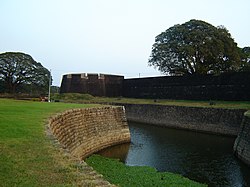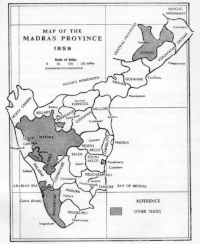Kerala was a major spice exporter as early as 3,000 BCE, according to Sumerian Records.
Kerala and Tamil Nadu once shared a common language and culture, within an area known as Tamilakam. In the 1st century BCE, Tamil-speaking Dravidian Villavars established the Chera Dynasty that ruled northern Kerala from a capital at Vanchi. Southern Kerala was ruled by the Pandyan Kingdom, with a trading port variously identified by ancient Western sources as "Nelcynda" and "Neacyndi" The Cheras had trading links with China, West Asia, Egypt and the Roman Empire. The value of Rome's annual trade with India as a whole was estimated at no less than 50,000,000 sesterces; contemporary Sangam literature describes Roman ships coming to Muziris in Kerala, laden with gold to exchange for pepper. One of the earliest western traders to use the monsoon winds to reach Kerala may have been Eudoxus of Cyzicus, around 118 or 166 BCE, under the patronage of Ptolemy VIII, king of the Hellenistic Ptolemaic dynasty inEgypt. Kerala is identified on the Tabula Peutingeriana, the only known surviving map of the Roman cursus publicus.
The Chera kings' dependence on trade meant that merchants from West Asia and Southern Europe established coastal posts and settlements in Kerala.:192–195, 303–307 The west Asian-semitic Jewish, Christian, and Muslim immigrants established Juda Mappila, Nasrani Mappila, andMuslim Mappila communities respectively. The Jews first arrived in Kerala in 573 BC. According to local Syriac Nasrani Christian tradition as well as the works of scholars and Eastern Christian writings, Thomas the Apostle visited Muziris in Kerala circa 52 CE to proselytize amongst Kerala's Jewish settlements.The first mosque, synagogue, and church in India were built in Kerala.
A later Chera Kingdom was established c. 800–1102, with the help of Arab spice merchants. This is also called the Kulasekhara dynasty, as it was founded by Kulasekhara Varman, a Vaishnavaite saint. Ay kings ruled southern Kerala, but by the 10th century the Ay kingdom declined and became a part of the Chera Kingdom. A Keralite identity, distinct from the Tamils, became linguistically separate during this period. The Kulasekhara dynasty came to an end by twelfth century, weakened by the invasions of Pandyas and Cholas. In the absence of a strong central power, the state fractured into small principalities governed by Nair chieftains. From these, the kingdoms of Kochi, Venad, Kolathiri and Kozhikode Samuthiri emerged.
[edit]The Colonial Era
The western spice-trade, especially in pepper, became increasingly lucrative. Around the 13th century, the Portuguese began to dominate the eastern shipping trade in general, and the spice-trade in particular, culminating in Vasco Da Gama's arrival in Kappad Kozhikode in 1498. On 25 March 1505, Francisco de Almeida was appointed Viceroy of Portuguese India, with headquarters at Kochi. The Portuguese had taken advantage of conflicts between Kozhikode andKochi to gain control of the trade, and established forts at Kannur, Cochin and Kollam but the Saamoothiri of Kozikode and his admiral Kunjali Marakkar resisted, and in 1571 the Portuguese were defeated at Chaliyam fort.
The weakened Portuguese were ousted by the Dutch East India Company, who took advantage of continuing conflicts between Kozhikode and Kochi to gain control of the trade. The Dutch in turn were weakened by constant battles with Marthanda Varma of the Travancore Royal Family, and were defeated at the Battle of Colachel in 1741. The Dutch were allied to French forces in the transcontinental Napoleonic Wars; forces of the British East India Company marched against them from Calicut and took their surrender and possessions on 20 Oct 1795. In 1766, Hyder Ali, the ruler of Mysore invaded northern Kerala; his son and successor, Tipu Sultan, launched campaigns against the expanding British East India Company, resulting in two of the four Anglo-Mysore Wars. Tipu ultimately ceded Malabar District and South Kanara to the Company in the 1790s; the Company forged tributary alliances with Kochi in 1791 and Travancore in 1795. Malabar and South Kanara became part of the Madras Presidency.
There were major revolts in Kerala against British rule in the 20th century, until Independence was achieved. They include the 1921 Malabar Rebellion and the 1946 Punnapra-Vayalar uprising in Travancore. Other actions by Kerala's political and spiritual leaders protested against social traditions such as untouchability, leading to the 1936 Temple Entry Proclamation that opened Hindu temples in Travancore to all castes; Malabar soon did likewise, and Cochin followed with a similar proclamation in 1948, after Independence. In the 1921 Moplah Rebellion, Mappila Muslims rioted against Hindu zamindars (see Zamindari system) and the British Raj.
Post Independence
After British India was partitioned in 1947 into India and Pakistan, Travancore and Cochin joined the Union of India and on 1 July 1949 were merged to form Travancore-Cochin. On 1 January 1950 (Republic Day), Travancore-Cochin was recognised as a state. The Madras Presidency was organised to form Madras State in 1947.
On 1 November 1956, the state of Kerala was formed by the States Reorganisation Act merging the Malabar district, Travancore-Cochin (excluding four southern taluks, which were merged with Tamil Nadu), and the taluk ofKasargod, South Kanara. In 1957, elections for the new Kerala Legislative Assembly were held, and a reformist, Communist-led government came to power, under E.M.S. Namboodiripad.The Communist government initiated pioneering land reforms, leading to lowest levels of rural poverty in India.




No comments:
Post a Comment